Hey there, future job seekers!
Are you ready to unleash your genius and crack the code for your dream campus placement? Well, you’ve come to the right place!
Landing that dream job right out of college can feel like reaching the pinnacle of success, and we’re here to ensure you achieve that summit. Whether you’re a fresh-faced freshman or a seasoned senior, we’ve covered you with tips, tricks, and strategies that will transform you into a placement-cracking superstar.
Picture this: You, walking into that interview room with confidence oozing from every pore, impressing the recruiters with your charm and wit, and ultimately landing that dream job. Sounds incredible, doesn’t it? Well, buckle up because we’re about to turn that fantasy into a reality!
In this comprehensive guide, we’ll take you on a ride, breaking down the entire process from start to finish. From mastering the art of resume crafting to acing those nerve-wracking interviews, we’ll leave no stone unturned. We’ll even spill the beans on those secret strategies and insider knowledge that will give you the edge over your competition.
Furthermore, we will provide invaluable guidance on how to choose your career, empowering you to make well-informed decisions that align with your aspirations and goals.
But hold on; we’re not here to bore you with boring lectures or mundane instructions. Oh no, dear reader, we believe in learning with a twist! That’s why we’ll infuse our advice with strategies that work, turning your preparation into an adventure you’ll enjoy. After all, who says landing your dream job can’t be a fun-filled journey?
Think of this guide as your hidden superpower, trusted mentor, and ultimate companion, all rolled into one.
So, gear up to sharpen your skills, polish your confidence, and unlock the door to your bright future. Get ready to soak in the wisdom of seasoned professionals and discover valuable resources. Together, we’ll turn your campus placement experience into an unforgettable story of triumph.
Are you feeling the surge of excitement? We certainly are! So, without further ado, let’s dive headfirst into this knowledge-packed guide and unravel the secrets enabling us to open that campus placement one step at a time.
Comprehensive guide to ace your campus placement in 2023
- Section 1: Self-Assessment and Career Selection
- Section 2: Upskill yourself
- Section 3: Resume Preparation
- Section 4: Virtual Interview Preparation
- Section 5: Technical and Domain Knowledge Preparation
- Section 6: Networking and Company Research
- Section 7: Personal Branding and Online Presence
- Section 8: Handling Offer Acceptance and Rejection.
- Section 9: Preparing for the First Day at a New Office
- Conclusion
Section 1: Self-Assessment and Career Selection
- Follow your passion
Reflect on the experiences and activities that ignited your interest during college. Create two columns – one for your hobbies, interests, and passions and another for your strengths, talents, and skills. Look for intersections between the two, where your passions align with your natural abilities. These matches can provide valuable insights into fulfilling potential career paths and utilizing your strengths.
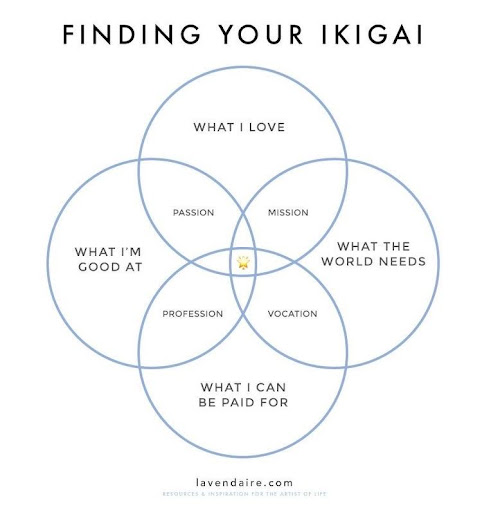
- Conduct Thorough Research
Be diligent in gathering information about various career options. First, leverage the vast online resources to explore different industries, job roles, and the necessary pathways for each. Then, take the initiative to delve deeper into the specifics, understanding the requirements, qualifications, and potential growth prospects. Remember, knowledge is power, and thorough research can empower you to make informed decisions about your career journey.
- Gain Hands-On Experience
Dive into the realm of your desired career by seeking out opportunities for internships or part-time jobs. These experiences allow you to immerse yourself in the field, gaining practical insights and relevant skills. They serve as a stepping stone towards understanding the intricacies of the career without committing to it long-term. Embrace the chance to learn and grow through firsthand experience.
- Connect with Professionals
Connect with professionals currently working in your chosen field for career advice. Contact them for informational interviews or engage with them through professional networking platforms by engaging in meaningful conversations and inquiring about their daily activities, challenges, and experiences. Gain an insider’s perspective on the career and benefit from their valuable insights and advice.
- Consult a Career Counselor
When in doubt, seek the expertise of a career counselor. These professionals have the knowledge and tools to guide you through the career selection. Career counseling goes beyond making immediate decisions; it empowers you with self-awareness and skills to navigate your career journey effectively. By engaging in counseling, you actively shape your future and make informed decisions aligned with your long-term aspirations.
By following these steps and considering these factors, you can make more informed decisions about your career goals. Remember that career path are not always linear, and it’s okay to reassess and adapt as you gain more experience and insights. It’s important to regularly evaluate your goals and make adjustments if necessary to ensure your career aligns with your evolving interests, strengths, and values.
Section 2: Upskill yourself
In today’s rapidly evolving job market, enhancing your skills and staying ahead of the curve is crucial. Upskilling yourself boosts your professional growth and increases your competitiveness in the job market.
This section will provide valuable insights and strategies to upskill yourself and expand your knowledge and capabilities effectively.
- Identify Skill Gaps
Start by assessing your skill set and identifying improvement areas. Next, look for high-demand skills or abilities that align with your career goals. This self-reflection will help you prioritize your upskilling efforts.
- Set Clear Goals
Define specific goals and objectives for your upskilling journey. It could include learning a new programming language, acquiring project management skills, or becoming proficient in data analysis. Setting clear goals will give you a sense of direction and purpose.
- Explore Learning Resources
Take advantage of a wide range of learning resources. Online platforms, such as e-learning websites, offer courses, tutorials, and certifications on various topics. Find reputable sources that provide quality content and choose a learning method that suits your preferences, whether video tutorials, interactive courses, or hands-on projects.
Enroll here: Learn Job ready skills from free online courses with certificates
- Embrace Continuous Learning
- Adopt a growth mindset and approach upskilling as a lifelong journey.
- Stay curious and remain open to new ideas and emerging technologies.
- Read industry publications, follow thought leaders on social media, and engage in online communities to stay updated with the latest industry news and best practices.
- Practice and Apply Your Skills
Actively apply the skills you learn through hands-on projects, internships, or volunteer work. Practical experience will reinforce your learning and demonstrate your abilities to potential employers.
- Monitor Your Progress
Regularly assess your progress and celebrate your achievements. Keep track of your acquired skills and how they contribute to your professional growth. This self-evaluation will help you stay motivated and make informed decisions about future upskilling endeavors.
Remember, upskilling is not a one-time event but an ongoing process. By continuously investing in your personal and professional development, you will enhance your marketability, adapt to changing industry demands, and position yourself for future career opportunities.
So, let’s embark on the upskilling journey and unlock your full potential!
Section 3: Resume Preparation
Your resume holds immense value in shaping your career, yet it can be overwhelming. Need to be more sure about condensing information or even what a resume format is? No matter what worries you may have, we’ve got you covered. We’ll provide a comprehensive guide on crafting an impeccable resume, starting from the basics.
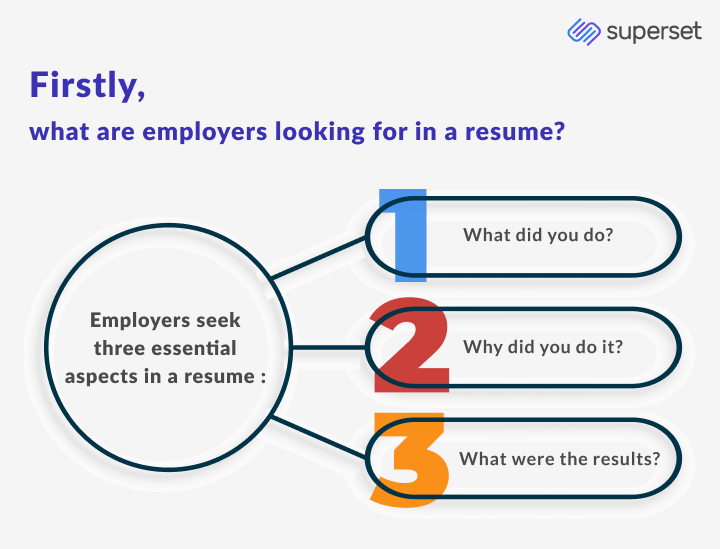
As career coach Martin McGovern advised, you can effectively guide your resume in the right direction by addressing these questions in your resume bullet points.
Using clear language, free from jargon and redundancy ensures readability. Consider the perspective of a recruiter unfamiliar with your role to enhance accessibility. Moreover, employers evaluate candidates based on how well they align with the job requirements, so your resume should depict your responsibilities and the unique value you offer to the organization.
Also, read 5 ways to get your Resume Recognised by Recruiters.
Let’s Understand the critical components of a well-crafted resume:
- Contact Information
Start your resume with your full name, professional title, phone number, email address, and your LinkedIn profile or personal website.
Here’s an example of how the contact information section may appear:
John Doe
Software Engineer
Phone: (123) 456-7890
Email: johndoe@email.com
LinkedIn: linkedin.com/in/johndoe
Website: johndoe.com
Remember to ensure that the contact information section is clear, easy to read, and accurately represents your current contact details.
- Resume Objective or Summary Statement
This section briefly overviews your career goals, relevant skills, and accomplishments. It should capture the employer’s attention and highlight what you can bring to the role.
Here’s how to create a practical objective or summary statement:
- Tailor it to the Job
- Highlight Your Value
- Keep it Concise
- Tailor the Format
- Use Strong Language
- Quantify Your Accomplishments
- Be Honest and Authentic
Here is an example to illustrate the difference between an objective statement and a summary statement:
Objective Statement:
Motivated and detail-oriented recent graduate seeking an entry-level marketing position to utilize strong analytical skills, creativity, and passion for digital marketing. Eager to contribute to driving brand awareness and implementing effective marketing strategies.
Summary Statement:
Motivated and ambitious marketing professional with a solid digital marketing foundation. Eager to leverage my educational background and passion for the industry to drive successful marketing campaigns. Proficient in market research, data analysis, and campaign optimization, focusing on learning and adapting to the latest trends. Demonstrated expertise in SEO, content marketing, and social media management, complemented by a strong drive to foster brand growth. Committed to delivering impactful marketing solutions that create a lasting impression.
- Professional Experience
- List your work history in reverse chronological order, starting with your most recent or current position.
- Include the company name, job title, dates of employment, and a concise description of your responsibilities and achievements in each role.
- Use action verbs and quantify your accomplishments whenever possible.
Here’s an example of the professional experience section for a marketing manager position:
- For entry-level students or freshers
- Motivated and ambitious marketing professional poised to launch a successful career in marketing management.
- Demonstrated proficiency in developing and executing comprehensive marketing strategies to drive brand awareness and customer acquisition.
- Adept at leveraging digital marketing channels, including SEO, SEM, email marketing, and social media advertising, at boosting website traffic and conversion rates.
- Collaborative team player experienced in cross-functional coordination to ensure consistent brand messaging.
- Skilled in market research and competitor analysis, contributing to increased market share.
- Proven ability to launch and promote new product lines, driving significant sales growth.
- Well-versed in managing budgets and optimizing spending for maximum ROI.
- Analytical mindset with a focus on leveraging data-driven insights to optimize campaign performance.
- Ready to bring energy, creativity, and a strong work ethic to contribute to marketing success in a marketing manager role.
- For professionals having experience more than 3 years
Marketing Manager
ABC Company, City, State | January 2018 – Present
- Develop and execute comprehensive marketing strategies to drive brand awareness and increase customer acquisition and retention.
- Managed a team of 5 marketing specialists, providing guidance, mentorship, and performance evaluations.
- Oversee digital marketing campaigns, including SEO, SEM, email marketing, and social media advertising, resulting in a 30% increase in website traffic and a 20% boost in conversion rates.
- Collaborate with cross-functional teams, including sales and product development, to ensure cohesive brand messaging and consistent marketing efforts.
- Conduct market research and competitor analysis to identify trends and opportunities, contributing to a 15% increase in market share.
- Successfully launched and promoted new product lines, resulting in a 25% increase in sales within the first quarter.
- Managed a marketing budget of $500,000, optimizing spending to achieve maximum ROI and cost savings of 10%.
- Utilize marketing analytics and KPI tracking to monitor campaign performance and make data-driven recommendations for optimization.
- Education
The education section of your resume provides information about your academic background and qualifications. In addition, it highlights your educational achievements, degrees earned, and any relevant coursework or academic achievements, or certifications.
Here’s how to effectively present your education details:
- Format: Start with the highest level of education you have completed and list your degrees in reverse chronological order. Include the following information for each degree:
- Degree Earned: State your degree (e.g., Bachelor of Science, Master of Business Administration, etc.).
- Field of Study/Major: Specify your major or area of concentration.
- Institution: Provide the name of the university, college, or educational institution you attended.
- Location: Include the city and state (and country, if applicable) where the institution is located.
- Dates: Mention the years of enrollment and graduation. If you haven’t graduated, indicate your expected graduation date or use “Anticipated” before the graduation year.
Here’s an example of how the education section may appear:
The University of Kentucky | Lexington, KY
B.A. in Accounting | Expected 2019
Prominent Coursework: Intro to Risk Management, Actuary Sciences
Honors: Member, Phi Mu Epsilon
Johnson Academic Achievement Scholarship
Waters High School | Waters, VA
Expected Diploma, 2016 (GPA: 3.6)
National Honor Society, Vice President
Marching Band, Section Leader
Remember, when listing your education, focus on the highest level of education completed or the most relevant degrees/certifications to the Job you’re applying for.
- Skills
The skills section of your resume highlights your relevant abilities, knowledge, and competencies applicable to the job you’re seeking. This section helps employers quickly identify your key strengths and qualifications.
Here’s how to effectively present your skills:
- Highlight your critical skills: They should be relevant to the Job you’re applying for.
- Use Keywords: Incorporate keywords from the job description into your skills section. It can help your resume pass through applicant tracking systems (ATS) and show alignment with the job requirements.
- Balance Hard and Soft Skills: Include a mix of hard skills (quantifiable, technical abilities) and soft skills (personal qualities, communication, leadership) to showcase a well-rounded skill set.
- Be Specific: Provide specific examples or context for each skill to demonstrate how you have applied or developed them in previous roles or experiences. It helps employers understand the depth of your expertise.
- Highlight Proficiency Levels: If relevant, indicate your proficiency level for specific skills. For example, you can use terms like “proficient in,” “advanced,” or “intermediate” to describe your level of expertise.
Here’s an example of how the skills section may appear:
Skills
Technical Skills: Java, Python, HTML/CSS, Microsoft Office Suite, Google Analytics
Marketing Skills: SEO, Social Media Marketing, Content Creation, Email Marketing
Project Management: Agile Methodology, Scrum, Team Collaboration
Communication: Written and Verbal Communication, Presentations, Client Relations
Languages: English (Native), Spanish (Intermediate)
- Certifications and Training
If you have obtained any certifications or completed relevant training courses, list them in this section. It can add credibility and demonstrate your commitment to professional development.
Here’s how to effectively present your certifications and training:
- Title: Clearly state the name of the certification or training program.
- Issuing Organization: Mention the organization or institution that provided the certification or training.
- Date of Completion: Include the month and year when you obtained the certification or completed the training.
- Relevance: Describe how the certification or training is relevant to the Job you’re applying for. Highlight the specific skills or knowledge gained through the program.
- Include Industry-Specific Certifications: Include any highly valued or recognized certifications in your industry.
- Professional Associations: If you are a member of any professional associations relevant to your field, mention them in this section.
Here’s an example of how the certifications and training section may appear:
Certifications and Training
Google Ads Certification
Issuing Organization: Google
Date of Completion: September 2022
Relevance: Demonstrates proficiency in Google Ads campaign management and optimization.
Advanced Excel Training
Issuing Organization: XYZ Training Institute
Date of Completion: July 2020
Relevance: Enhanced proficiency in data analysis, formulas, and advanced functions in Microsoft Excel.
- Projects or Portfolio
If you have completed noteworthy projects or have a portfolio, consider including a section where you can showcase your work. It is significant for creative or technical roles.
- Awards and Achievements:
Including an awards and achievements section in your resume effectively highlights your notable accomplishments and demonstrates your exceptional performance.
Here’s how to effectively present your awards and achievements:
- Professional Affiliations: Include any relevant professional memberships or affiliations, such as industry associations or organizations you are a part of.
- Section Heading: Create a dedicated “Awards and Achievements” or “Honors and Recognition” section to separate this information from your other resume sections.
- List Noteworthy Awards: Include awards, honors, commendations, or recognition relevant to your professional achievements. These can be industry-specific accolades, academic integrity, or workplace recognition.
- Provide Context: Briefly describe the significance or context of each award or achievement. For example, mention the recognition criteria or how you stood out among your peers.
- Highlight Impact and Results: Whenever possible, mention the impact or results associated with each award or achievement. For example, quantify the improvement you brought to a project, the percentage increase in sales, or the positive feedback from clients.
- Keep it Recent and Relevant: Focus on recent awards and achievements directly related to your field or the Job you’re applying for. If you have a long list of awards, select the most impressive or relevant ones.
Here’s an example of how the awards and achievements section may appear:
Awards and Achievements
Employee of the Year
ABC Company, City, State | 2021
Recognized for outstanding performance, leadership, and consistently exceeding targets.
Dean’s List
XYZ University, City, State | 2018 – 2020
Recognizes academic excellence and ranking in the top 10% of the graduating class.
Sales Excellence Award
ABC Corporation, City, State | 2019
Received for achieving 150% of the sales target and leading the team in revenue generation.
Volunteer of the Year
Community Organization, City, State | 2017
Commended for dedication and impactful community service initiatives.
References
You can either include a line stating that references are available upon request or provide a separate sheet with contact information for individuals who can vouch for your skills and character.
- Proofread your resume thoroughly for grammar and spelling errors
Proofreading is a crucial step in creating a polished and error-free resume. It demonstrates attention to detail and professionalism, enhancing your chances of making a positive impression on potential employers.
When proofreading a resume for grammar and spelling errors, here are some steps a candidate can follow:
- Read Aloud: Read each section of your resume aloud. It can help you catch awkward phrasing, repetitive words, or missing punctuation.
- Check Grammar and Spelling: Carefully review each sentence for grammar and spelling errors. Pay attention to subject-verb agreement, verb tenses, punctuation, and correct word usage.
- Use Spelling and Grammar Tools: Utilize spelling and grammar-checking tools available in word processors or text editors. Tools like Grammarly, Wordtune, and Hemmingway can help you proofread it better. However, these tools may not catch all errors, so manual proofreading is crucial.
- Review Sentence Structure: Check the structure of your sentences to ensure they are clear and concise. Avoid run-on penalties and ensure proper punctuation.
- Check for Consistency: Ensure consistency in formatting, capitalization, and punctuation throughout your resume. Verify that headings, bullet points, and dates are formatted consistently.
- Double-Check Dates and Numbers: Verify that all dates, job durations, and numerical data (such as percentages or revenue figures) are accurate and consistent.
- Seek a Second Opinion: Consider asking a friend, family member, or trusted colleague to review your resume. They may spot errors or provide valuable feedback.
Here’s a tip:
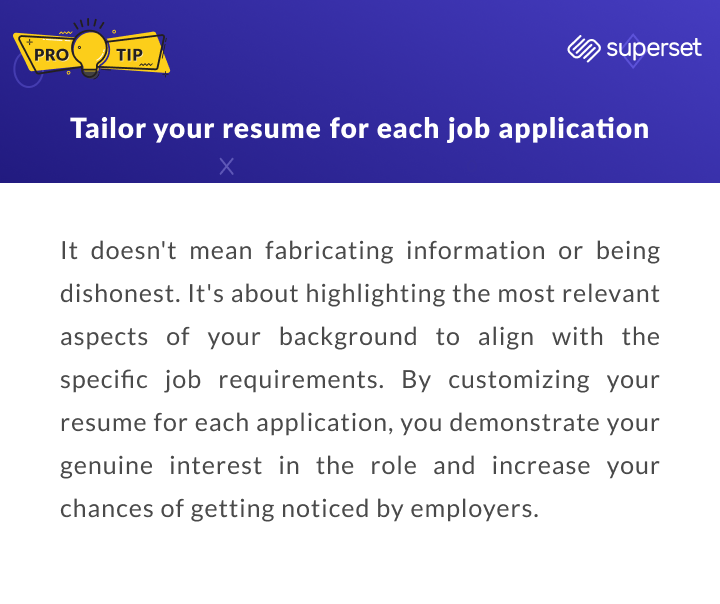
Also: Don’t forget your CV. Read here on how to tailor it.
Section 4: Virtual Interview Preparation
In today’s dynamic and interconnected world, where technological advancements have transformed how we work and connect, virtual interviews have emerged as the new frontier of the hiring process. Gone are the days of stuffy conference rooms and nervous handshakes; now, job seekers can showcase their skills and talents from their own space.
Virtual interviews have revolutionized the hiring landscape, breaking down geographical barriers and opening doors to global opportunities. As the digital realm continues to shape our professional interactions, candidates must adapt and master the art of virtual interviews.
Our guide offers a wealth of interview preparation tips and advice specifically tailored to help you confidently navigate the virtual interview process. By equipping yourself with these valuable insights, you will be well-prepared to seize opportunities and enhance your prospects of securing your desired job.
In this section, we will delve into the secrets of virtual interview success, providing you with insider tips, expert strategies, and the confidence to stand out amidst the pixelated crowd.
- Set up a professional, distraction-free virtual interview environment
- Find a quiet and well-lit space for your interview.
- Choose a location with minimal background noise and ensure no distractions around you.
- Keep your surroundings tidy and presentable.
- Before the interview, check your audio and video settings to ensure they function correctly.
- Test your internet connection to avoid any technical issues during the interview. It’s recommended to use headphones with a built-in microphone for clear audio.
- Familiarize yourself with the virtual interview platform
If the employer has specified a particular platform for the interview, such as Zoom, GMeet, Microsoft Teams, or Skype, take the time to become familiar with its features. For example, learn how to join meetings, use the mute/unmute option, share your screen if necessary, and use the chat function.
- Research the company and position thoroughly
Conduct in-depth research on the company to comprehensively understand its values, culture, and industry. In addition, study the job description and requirements thoroughly. This knowledge will enable you to tailor your answers to align with the company’s needs and demonstrate your genuine interest in the role.
- Practice common interview questions
Prepare responses to common interview questions that may be asked, such as “Tell me about yourself,” “Why are you interested in this position?” or “Describe a challenge you faced and how you overcame it.” Practice delivering concise, impactful answers highlighting your skills, experiences, and achievements. Use the STAR method (Situation, Task, Action, Result) to structure your responses.
Read here: 10 Common Job Interview Questions and How to Answer Them
- Develop your storytelling skills
Use storytelling techniques to communicate your experiences and achievements effectively. Craft compelling narratives highlighting your skills and demonstrating how you’ve contributed value in previous roles. Focus on providing specific examples, emphasizing the challenges you faced, the actions you took, and the positive outcomes you achieved.
- Engage in mock interviews
Preparing for a mock interview is a valuable step in your interview preparation process. By engaging in mock interviews, whether online or in person, you can simulate the interview environment and gain confidence in your responses. Consider practicing mock interviews with friends, family members, or career services professionals who can provide valuable feedback.
During these sessions, pay close attention to your communication style, body language, and overall presentation, as they are crucial in making a positive impression. Mock interview practice is especially beneficial for students or individuals new to the job market, as it helps build experience and refine interview skills.
- Access comprehensive resources on virtual interview tips
Seek out extensive resources, guides, or blogs that provide in-depth information and strategies specifically for virtual interviews. Online career websites, professional blogs, or industry-specific publications often offer valuable insights, best practices, and additional advice for successful virtual interviews.
Read here: Virtual Job Interviews: Dos and Don’ts to Ace Them
Regardless of whether you’re engaging in a virtual interview or participating in an online assessment, implementing these interview techniques will enable you to effectively demonstrate your interview skills and differentiate yourself from other candidates. With these strategies, you will confidently navigate virtual interviews, leave a powerful impression on potential employers, and significantly improve your likelihood of securing your desired job.
Section 5: Technical and Domain Knowledge Preparation
In the ever-evolving landscape of today’s job market, the acquisition and enhancement of technical skills and domain knowledge have become paramount for individuals aspiring to excel in their desired roles. Furthermore, as industries evolve and embrace digital transformation, employers increasingly seek candidates with solid technical expertise and a deep understanding of their respective domains.
This section aims to guide you on your journey towards technical and domain knowledge preparation, equipping you with the strategies necessary to thrive in your chosen career path.
- Identify key technical skills and domain knowledge
Research the specific technical skills and domain knowledge in high demand for your desired job roles. Review job descriptions, industry trends, and professional networking platforms to gain insights into the skills and knowledge sought by employers.
- Enhance skills through online courses, tutorials, workshops, or certifications
Use online learning platforms, tutorials, workshops, and certifications to develop and enhance your technical skills. These resources offer structured learning opportunities, allowing you to acquire knowledge conveniently.
- Engage in hands-on projects or internships
Apply your skills in real-world scenarios by participating in hands-on projects or securing internships. The practical experience reinforces your technical skills and provides valuable insights into the practical application of your knowledge within a professional setting.
- Stay updated with the latest trends and developments
Keep abreast of your chosen field’s latest trends, advancements, and developments. To stay informed, subscribe to industry newsletters, follow relevant blogs, join professional communities, and attend webinars or conferences. It demonstrates your enthusiasm for continuous learning and adaptability.
- Practice coding, problem-solving, and analytical skills
Dedicate time to practice coding, problem-solving, and analytical skills. Utilize coding platforms, participate in coding challenges or competitions, and solve mock tests to sharpen your technical understanding. It helps improve your problem-solving abilities and prepares you for technical assessments during interviews.
Remember that technical skills and domain knowledge are ever-evolving. Continuously investing in professional development and staying updated with emerging technologies and industry trends will give you a competitive edge in the job market. Employers value candidates with the right mix of technical expertise and domain knowledge backed by practical experience and a commitment to ongoing learning.
Also read: Must have skills to crack your campus placements
Section 6: Networking and Company Research
Networking and company research go hand in hand, enabling you to establish meaningful connections, gain valuable insights, and tailor your approach when pursuing opportunities. By building a robust professional network and conducting thorough research, you’ll position yourself as a well-informed and engaged candidate, increasing your chances of success in the competitive job market.
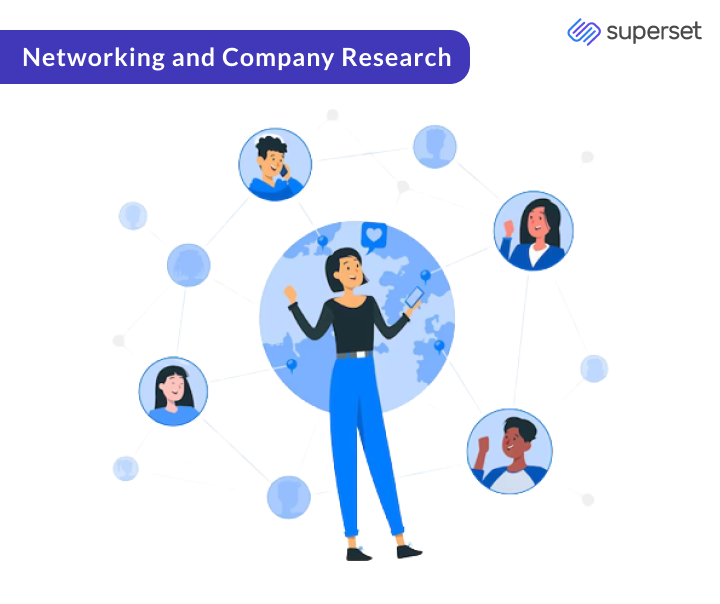
Consider the following pointers to build connections and gather valuable insights:
- Build a solid professional network
Leverage platforms like LinkedIn, attend career fairs, and connect with alum associations to expand your professional network. Engage in meaningful conversations, attend industry events, and participate in online communities to establish valuable connections with professionals in your field.
- Reach out for informational interviews or guidance
Proactively contact professionals in your target companies or industries. Request informational interviews to gain insights into their experiences and seek guidance on career paths. Their valuable advice can give you a deeper understanding of the industry and potentially open doors to opportunities.
- Research your target companies
- Dedicate time to research the companies you are interested in thoroughly.
- Explore their websites, social media platforms, and other reliable sources to understand their mission, values, products, and services.
- Familiarize yourself with their organizational structure and key stakeholders.
- Stay updated with the latest news and announcements
Keep yourself informed about your target companies’ latest news and notifications. Set up Google alerts, follow their social media accounts, and subscribe to industry newsletters to stay abreast of important updates, new projects, or advancements. This knowledge will help demonstrate your interest and enthusiasm during networking conversations or interviews.
- Utilize company resources
Like a master detective, follow the trail of breadcrumbs left by companies across their digital landscape. To gather relevant information, utilize the resources on the company’s website, such as its blog, press releases, or annual reports. In addition, pay attention to their company culture, recent achievements, and any initiatives they are involved in. This information can be helpful when networking or tailoring your application materials.
In networking and company research, curiosity becomes your compass, and connections become the portals to opportunity. So embrace the journey of exploration, armed with a sense of wonder and a hunger for knowledge.
Section 7: Personal Branding and Online Presence
In today’s digital age, personal branding and online presence have become paramount in establishing a solid professional identity and standing out in a crowded job market. Just as a well-crafted brand captures attention and leaves a lasting impression, your brand is your chance to showcase your unique skills, experiences, and passions to the world.
With the click of a button, you can shape how others perceive you, paint a vivid picture of your professional journey, and open doors to exciting opportunities. Through carefully curated online profiles, engaging content, and thoughtful interactions, you can establish yourself as a thought leader and cultivate a network of valuable connections.
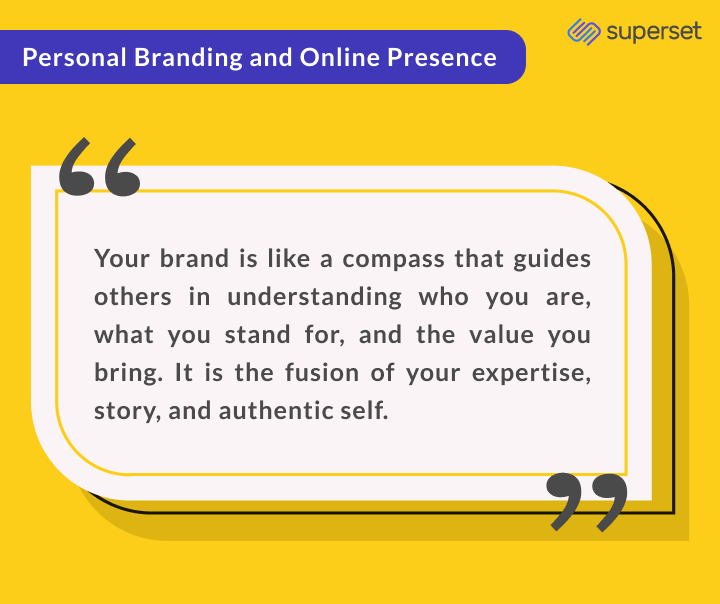
By strategically crafting your brand, you can create a compelling narrative that resonates with your target audience and captures the attention of potential employers.
Take the following steps to build a solid personal brand and establish a compelling online presence:
- Develop a strong personal brand
Define your unique value proposition and craft a compelling narrative that showcases your skills, experiences, and achievements.
- Identify your strengths and align them with your career goals
Create a consistent and authentic personal brand that differentiates you from the competition.
- Create an impressive LinkedIn profile
LinkedIn has become the go-to platform for professionals worldwide. Create a compelling LinkedIn profile highlighting your professional journey, skills, accomplishments, and aspirations. Optimize your profile with relevant keywords and ensure it reflects your brand. Regularly update your profile with new achievements and experiences.
- Share industry-related content and insights
Position yourself as an industry thought leader by sharing valuable content, wisdom, and projects related to your field. Write articles, share relevant news, and contribute to discussions on professional platforms. It demonstrates your expertise, passion, and commitment to staying informed about industry trends.
- Engage with industry professionals and join relevant groups
Actively engage with industry professionals, connect with like-minded individuals, and join relevant groups on professional platforms. Participate in discussions, share insights, and contribute to the community. It expands your network, exposes you to new opportunities, and enhances your visibility within your industry.
Also, you can watch
Section 8: Handling Offer Acceptance and Rejection.
Congratulations! You’ve put in the hard work and aced interviews, and now it’s time to navigate the exciting phase of offer acceptance and rejection. This stage of your job search journey involves important decisions, effective communication, and maintaining positive relationships. How you handle these situations can shape your professional trajectory and set the tone for future opportunities.
Handling offer acceptance and rejection is about the immediate outcome, building a reputation for professionalism, and leaving a positive impression throughout the process. So, let’s dive in and discover practical strategies for handling offer acceptance and rejection, empowering you to make informed decisions and laying the foundation for a successful and fulfilling career journey.
Here are key points to consider when handling offer acceptance and rejection:
- Evaluate job offers
Take the time to thoroughly evaluate job offers based on various factors such as compensation, growth opportunities, work culture, and job responsibilities. Consider how each offer aligns with your long-term career goals and personal aspirations.
Here’s an example of evaluating job offers:
Let’s say you have received two job offers: one from Company A and another from Company B. It’s time to put on your evaluation hat and consider the factors that matter to you.
- Compensation
- Compare the salary packages offered by both companies.
- Consider not just the base salary but also bonuses, benefits, and any additional perks they may offer.
- Consider your financial goals and how each offer aligns with them.
Example: Company A offers a higher base salary, but Company B provides a comprehensive benefits package, including health insurance, retirement plans, and flexible working hours, which could contribute to a better work-life balance.
- Growth opportunities
Assess each company’s career growth and advancement potential. Look at training programs, mentorship opportunities, and potential promotions.
Example: Company A offers a structured mentorship program and clear paths for career advancement, while Company B emphasizes cross-functional training and provides opportunities to work on diverse projects, allowing for skill development and broader experiences.
- Work culture
Research and gather insights about each company’s work culture and values. Consider team dynamics, management style, and the overall work environment.
Example: Company A fosters a collaborative and team-oriented culture, with regular team-building activities and an emphasis on work-life balance. On the other hand, Company B promotes an entrepreneurial and fast-paced environment where employees are encouraged to take ownership of their projects and think outside the box.
- Job responsibilities
Evaluate each job offer’s specific role and responsibilities. Consider the tasks you will perform, the autonomy level, and how they align with your skills and interests.
Example: The role at Company A involves leading a team and managing complex projects, offering opportunities to showcase leadership skills. At Company B, the part focuses on innovative research and development, allowing for creative problem-solving and cutting-edge technology involvement.
After evaluating these factors, reflect on how each offer aligns with your long-term career goals and personal aspirations. Finally, consider the overall package, weighing the importance of each element to make an informed decision that sets you on the path to success and fulfillment.
By evaluating Job offers holistically, you can make an informed decision that aligns with your long-term career goals and personal aspirations. Remember, it’s not just about the paycheck but about finding the right fit to nurture your growth and fulfill your professional journey.
- Accepting the offer
Congratulations! You’ve received a job offer, and now it’s time to take the exciting step of accepting it. Accepting the offer means formally agreeing to the terms and conditions outlined by the employer and showing your commitment to joining the company.
When accepting an offer, it’s essential to communicate your decision professionally and promptly. It involves expressing your gratitude for the opportunity and confirming your job acceptance. It’s also an opportunity to seek clarification on any doubts or questions regarding the terms, start date, or the onboarding process. Open communication ensures a smooth transition into your new role and helps set clear expectations.
By confidently accepting the offer, you’ll take a significant step towards embarking on a new and exciting career journey.
Here’s an example of accepting a job offer while clarifying any doubts or questions you may have:
Dear [Hiring Manager’s Name],
I hope this email finds you well. I sincerely appreciate extending the job offer for the [Job Title] position at [Company Name]. I am genuinely excited about the opportunity to join the team and contribute to the continued success of [Company Name].
After careful consideration, I am delighted to accept the offer to join [Company Name]. My skills and experience align well with the requirements of the role, and I am eager to make a positive impact in this capacity.
Before I officially begin, I would appreciate some clarification on a few crucial matters to ensure a smooth transition into my new role. Firstly, I would like to confirm the agreed-upon terms and conditions, including the salary, benefits package, and any additional incentives. In addition, receiving a detailed breakdown of the compensation package will ensure we are on the same page.
Secondly, I request information regarding the proposed start date and any paperwork or documentation required before joining. Finally, if any pre-employment formalities or onboarding procedures need my attention, please guide how I can best fulfill those requirements.
Lastly, I am eager to learn more about the onboarding process and how I can familiarize myself with the team, company policies, and relevant training programs. Please share an overview of the onboarding timeline and provide any materials or resources that will help me hit the ground running.
Once again, I am grateful for this opportunity and my enthusiasm to contribute to the success of [Company Name]. I am confident that, together, we will achieve great things. I look forward to working closely with the team and making a meaningful impact.
Thank you for your time and support. I am excited to embark on this new journey and contribute to the continued growth and success of [Company Name].
Sincerely,
[Your Name]
In this example, the candidate accepts the job offer and takes the opportunity to seek clarification on specific details such as the terms and conditions, start date, and the onboarding process. This proactive communication ensures a smooth transition and helps set clear expectations.
Remember to customize the example to reflect your questions and concerns, and maintain a positive and appreciative tone throughout your acceptance.
- Politely declining offers
Politely declining offers is also an essential aspect of the job search process, especially when you have received multiple offers and need to decide when declining offers from other companies; handling the situation with professionalism and tact is crucial.
Here’s an example of politely declining a job offer while expressing gratitude and leaving the door open for potential opportunities:
Dear [Hiring Manager’s Name],
I hope this email finds you well. I am grateful for extending the job offer for the [Job Title] position at [Company Name]. In addition, I am genuinely thankful for the time and effort you and the team invested in the selection process.
After careful consideration, I have decided to decline the offer. This decision was not taken lightly, as I greatly respect [Company Name] and your impressive work. However, I have received another offer that aligns more closely with my long-term career aspirations and personal circumstances.
My decision does not reflect any shortcomings on the part of [Company Name]. On the contrary, I was highly impressed with the organization’s values, culture, and the exciting opportunities presented by the role. The difficult part was choosing between two equally appealing paths, and after much reflection, I thought the other offer was the best fit for my current career goals.
I am grateful for the time and consideration given to my application. The positive interactions I had with everyone at [Company Name] left a lasting impression, and I genuinely appreciate the opportunity to have been a part of the selection process.
While I am declining the offer now, I sincerely hope we can keep the lines of communication open. I believe in [Company Name] ‘s great work and welcome collaboration opportunities. Please consider me as a candidate for any relevant roles that may arise in the future.
Once again, thank you for your understanding, and please extend my gratitude to the entire team. I wish [Company Name] continued success and hope our paths may cross again someday.
Warm regards,
[Your Name]
In this example, the candidate respectfully declines the job offer, expressing gratitude for the opportunity and highlighting their admiration for the company. The email maintains a positive and professional tone throughout, opening the door for potential future opportunities.
Remember to customize the example to reflect your situation and sentiments.
By declining offers gracefully, you uphold your professional reputation and leave a positive impression on the company. Remember, the job market is ever-evolving, and circumstances may change. Keeping the lines of communication open and maintaining a positive relationship can lead to future opportunities that align even better with your goals and aspirations.
Section 9: Preparing for the First Day at a New Office
Congratulations on securing a new job! As you eagerly await your first day at the office, ensuring you’re fully prepared for a smooth transition is essential. The first day at a new office sets the tone for your journey with the company, and being well-prepared can help you make a positive impression from the start.
This section will guide you through the essential steps to take before and during your first day to make a positive impression and set the stage for a successful start.
- Review Company Policies and Dress Code.
Familiarize yourself with the company’s policies, procedures, and any materials provided before your first day. Pay attention to the dress code and ensure you dress professionally and appropriately.
- Prepare Necessary Documents and Paperwork
Gather all the necessary documents, identification, and paperwork required for onboarding. It may include your identification documents, banking details, tax forms, and any other documents the company requests.
- Research Your New Colleagues and Team Members
Take the time to research your new colleagues and team members. Familiarize yourself with their roles, responsibilities, and backgrounds. It will help you establish connections more easily and understand the dynamics of your team.
- Be Punctual and Dress Professionally
- Make a positive impression on your first day by arriving on time.
- Plan your commute and factor in any potential delays.
- Dress professionally according to the company’s dress code, reflecting your seriousness and commitment to your new role.
- Approach the Day with a Positive Mindset
- Embrace your first day positively.
- Be open to learning, eager to contribute, and ready to absorb information.
- Take the opportunity to introduce yourself, ask questions, and demonstrate your enthusiasm for the Job.
By following these steps and preparing adequately, you can start your new office job on the right foot.
Remember, the first day is just the beginning of your journey, so stay proactive, adaptable, and focused on making a positive impact in your new workplace.
Conclusion
Cracking your campus placement is not just about landing a job; it’s about unlocking doors to a world of opportunities and setting the stage for an incredible career ahead. So let’s embark on this thrilling adventure and show the world you’re ready to shine professionally. Get ready to crack your campus placement, one smile and success story at a time!
Good luck!
Frequently Asked Questions
Is it easy to get job in campus placement?
Campus placement drives entail a major concern for students in their final year of college - securing a job. To be honest, acing the campus placement interview isn't much of a challenge. The key to scoring the job of your dreams is preparation. Job hunting can be a daunting task.
What is the eligibility for campus placement?
While most companies require at least 60% of the total quota, some companies will also accept 50% of the total quota for Years 10 and 12, depending on the candidate's job role and overall situation.
What not to do in a virtual interview?
Don't make these 5 virtual interview mistakes—they'll 'sabotage your candidacy' and cost you your job Avoid eye contact or staring into space. Sitting in a messy room. Screen sharing leaves inappropriate tabs or applications open. Use an unprofessional background. Interrupted by family members.
What is the best dress for a virtual interview?
In general, it's best to dress professionally and business attire in order to make a good first impression on the hiring manager. Here are some examples of what you might wear during a Zoom interview: Shirt or button-up: Wear a button-up or shirt during your Zoom interview.
How do you politely reject a job offer?
I would like to express my sincere thanks for being offered the position of [job title] at [company name]. While I appreciate the opportunity, I choose to respectfully decline the offer because I have received an offer that is more in line with my career goals and aspirations.
Can we reject offer after acceptance?
Rejecting a job offer after you've already accepted it can be an uncomfortable experience. However, as long as you have not signed an employment contract with the company, the law allows you to change your mind.
What to expect on first day at work?
Over the course of your first day, you will probably do the customary stint around the plant, and you could be in for a lot of prolusions. While utmost will just be a handshake and swapping of names, you should prepare a quick elevator speech about yourself and what you will be doing at the company.








